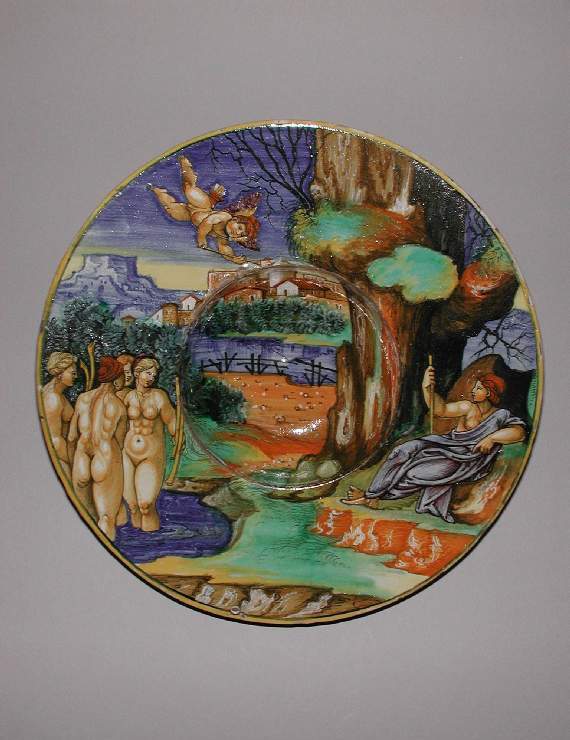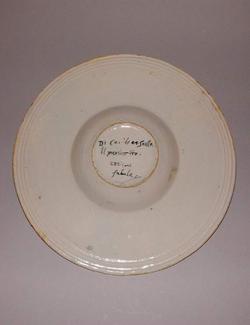Current Location: In storage
Titles
Scylla, Cupid and four Nymphs bathing
Maker(s)
Painter:
Avelli, Francesco Xanto
Entities
Categories
Description
Maiolica bowl with broad rim, painted in polychrome with Scylla, Cupid and four Nymphs bathing.
Pale buff earthenware, tin-glazed overall; the reverse pale beige. Painted in blue, green, yellow, orange, brown, manganese-purple, black, and white. Circular with a broad, almost flat rim and small, deep well. The underside of the rim is moulded with three shallow concentric grooves. (Poole 1995, Shape 57), Scylla, Cupid and four Nymphs bathing. On the right, Scylla reclines on a bank beside a massive rock formation. She holds a wand in her right hand. On the left, four nymphs holding long horns stand in a pool. Above, Cupid, holding a flaming torch, flies towards Scylla. In the foreground there is grass; in the background, landscape with a town and mountains. The outer edge is yellow. The back is inscribed in the middle in dark blue: `Di Car 'de et Scilla/Il parlameto./fabula y' (Of Car de and Scilla The conversation [?]. fable y).
Notes
History note: Unknown before Louis C.G. Clarke, LL.D. (1881-1960), Leckhampton, Cambridge
Legal notes
L.C.G. Clarke Bequest, 1960
Measurements and weight
Diameter: 26.2 cm
Height: 3.5 cm
Acquisition and important dates
Method of acquisition: Bequeathed
(1960-04-27)
by
Clarke, Louis Colville Gray
Dating
Second quarter of 16th century
Renaissance
Circa
1528
CE
-
1531
CE
Note
The scene probably represents Scylla taking refuge with the sea nymphs, to whom she told tales of her rejected suitors, mentioned in Ovid's 'Metamorphoses', XIII, 730-7. After Galatea had told Scylla and the nymphs about her love for Acis and the jealousy of the Cyclops, they returned to the sea, but Scylla remained alone on the shore (lines 898-900). Although unsigned, this dish can be attributed to Xanto Avelli da Rovigo on the basis of style, the literary and printed sources used, and handwriting on the reverse. One of the most characteristic features of his istoriato designs was that he frequently created scenes by copying figures from different printed sources. On this dish they were taken from two prints. Scylla was copied from the Muse Euterpe in the engraving of Parnassus by Marcantonio Raimondi after Raphael.The ultimate source for this figure was the famous antique marble Ariadne in the Vatican.This figure appears in several of Xanto's composi¬tions, for example, as Circe on the Fitzwilliam's dish decorated with 'Ulysses commanding Circe to restore his Companions to their Rightful Forms' (C.1-1953). The Cupid is either a reversed and upside-down version of the lower of two putti on the right of the same print or the middle putto of three on the other side. The four nymphs were drawn from Muses on the left of the' Contest between the Muses and the Pierides' engraved by G.G. Caraglio after Rosso Fiorentino.
Xanto used the word favola or fabula (fable) at the end of inscriptions on his work between 1528-31, after which he signed with several versions of his name or shortened forms of it.
The same figure of Scylla and and the nymphs appear together on at least three further dishes of the same wide-rimmed bowl form. One in the Victoria and Albert Museum (C.2233-1910), decorated with the same figure of Scylla and a group of five nymphs from the same printed sources, but with a different background and a central coat-of-arms, is inscribed 'Exorta Galatha silla ad amare fabula y' (Galatea exhorts Scylla to love fable y). The second from the Pucci Service, dated 1532, is decorated with Galatea, Scylla and the Cyclops, and inscribed 'A' Scylla parla Galath/ea d'amore' (Galatea speaks to Scylla of love), The third in the Hatton Gallery, Newcastle upon Tyne (Tyne and Wear Archive and Museums inv. NEWHG;S0004)is decorated with Scylla, and two groups of nymphs and a central shield charged with a man astride a lion wrenching its jaws open (perhaps Hercules), and inscribed .1531./Di Silla & di Carib/di parlamenti. favola.//fra:Xato.A.Rov/igiese i Urbino/pi:'(Discussions of Scylla and Charybdis. Fable. Francesco Xanto Avelli of Rovigo painted it in Urbino).
Timothy Wilson has suggested, probably rightly, that the partly missing word at the beginning of the inscription on the Fitzwilliam's dish was probably Caribde rather than Cupide, although the painter seems to have made a mistake in associating Carybdis with the story about Scylla and Galatea on the front.
School or Style
Renaissance
People, subjects and objects depicted
Components of the work
Decoration
composed of
high-temperature colours
( blue, green, yellow, orange, brown, manganese-purple, black, and white)
Materials used in production
Tin-glaze
Earthenware
Techniques used in production
Moulding
: Pale buff earthenware, tin-glazed overall; the reverse pale beige. Painted in blue, green, yellow, orange, brown, manganese-purple, black, and white.
Tin-glazing
Inscription or legends present
- Text: Di Car . 'de et Scilla/Il parlameto./fabula y
- Location: On the back
- Method of creation: Inscribed in dark blue
References and bibliographic entries
Related exhibitions
Identification numbers
Accession number: C.83-1961
Primary reference Number: 76197
Stable URI
Audit data
Created: Saturday 6 August 2011
Updated: Tuesday 30 April 2024
Last processed: Tuesday 2 September 2025
Associated departments & institutions
Owner or interested party:
The Fitzwilliam Museum
Associated department:
Applied Arts





